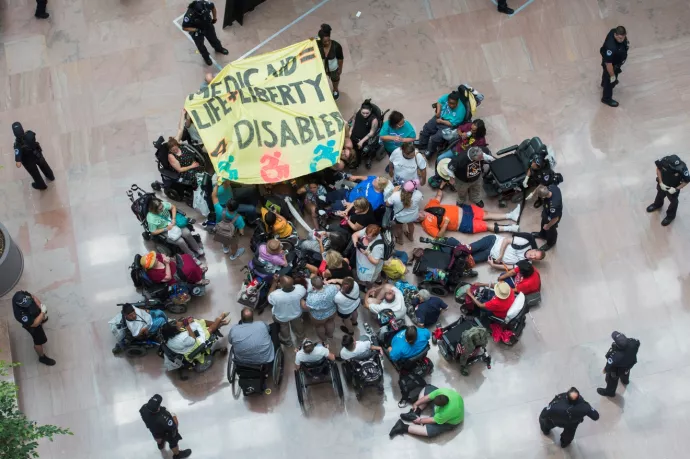
UTM sociologist chronicles 60 years of visible protest in the disability movement
Over the past 60 years, people with disabilities have led visible protests over a variety of issues including accessible transit, healthcare policies, and negative portrayals of disability in movies and television.
University of Toronto Mississauga sociology associate professor David Pettinicchio details these varied issues and related protests within the disability movement in his latest book Sixty Years of Visible Protest in the Disability Struggle for Equality, Justice, and Inclusion – as well as the different tactics that advocates used over time to complement visible protest. It also discusses how these protests have remained distinct, yet connected, over the decades.

“This book focuses on protest, but still takes into account the trajectory of the movement and the different issues that matter for the movement,” explains Pettinicchio.
“I look at everything from protests around healthcare, to protests around the show Big Brother and [2008 feature film] Tropic Thunder for using the R-word. It’s a very broad range of things that the movement engages in, and they engage in these things differently at different points in time.”
Pettinicchio says his research for this book ties in with his ongoing work at UTM, where he tries to understand why inequality exists, and what people do to mitigate that inequality.
Social movements, he says, are one way people can challenge inequality.
In the book, published by Cambridge University Press, Pettinicchio describes the disability movement’s different waves of visible protest in the United States.
Each wave used distinct tactics and focused on different issues. The first wave was marked by protests that were more reactionary, he says, beginning with the U.S. government’s inability to follow through on its promise to deliver disability rights.
Tactics used during this period demonstrated the importance of the attention-grabbing quality of visible protest, Pettinicchio says, such as sit-ins at government offices and stopping traffic to protest the lack of public transit accessibility.
Over time, he says that visible protest still used similar tactics from the first wave but also took a more “proactive approach” – focusing on issues such as healthcare and social programs, which largely occurred during the movement’s second wave. In the third wave, issues extended to include the way disability was portrayed in the media, movies, and on television.
He adds that more recently, the disability movement has borrowed tactics from other movements, such as the Black Lives Matter and the Occupy movements.
“I think what you see in the last 20 years is that the (disability) movement is much more sophisticated, because it’s a mature movement,” Pettinicchio says, adding that he would argue that the disability movement also influenced the way other movements use protests to create change.
Pettinicchio adds that it has been interesting to see the disability movement begin to focus on issues that also impact other groups seeking equity and justice. For example, when Republicans tried to repeal the Affordable Care Act (informally known as Obamacare), he says that disability rights advocates played a very prominent role in protests.

“Over time, the kinds of issues that the disability rights movement has gotten involved with are very important to disability, but they also transcend boundaries,” Pettinicchio explains. “They matter for poor people. They matter for people of colour, for women, for LGBTQ people.”
He says that the kinds of issues disability advocates mobilize around today impact everybody – including healthcare, social welfare, public transportation, education, and media portrayals – which can bring groups seeking equality and justice together in solidarity to challenge societal problems in the future.
“In the last 20 years, you see a lot more of this coalition building and efforts to really come together to remind people that we’re all on the same page – and when it comes to these kinds of things, why not mobilize our resources collectively to challenge these problems?” Pettinicchio says.
He adds that the success of the disability movement’s protests has been varied. For instance, social welfare has been least successful because of the complexities of government budgets, but the movement has been successful in drawing attention to negative media portrayals and the use of the R-word.
However, Pettinicchio points out that progress is not linear, and can often be one step forward and two steps back.
“Even if we think things are settled and achieved, like the Americans with Disabilities Act, it doesn’t mean that we won’t need people to mobilize and to keep vigil over efforts to try to repeal and undermine those kinds of things,” he says. “We cannot be lulled into a false sense of security simply because we got a policy. It’s a great achievement, but it’s not the end of political struggles. In many ways, it could be the very beginning of those struggles.”
